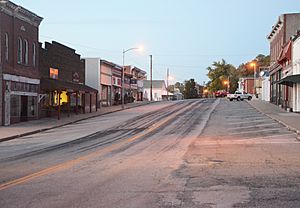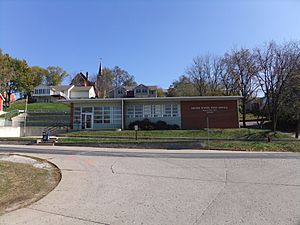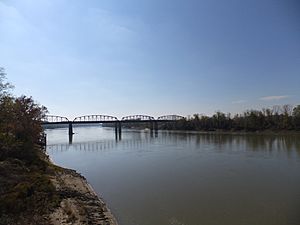Glasgow, Missouri facts for kids
Quick facts for kids
Glasgow, Missouri
|
|
|---|---|

1st Street in Glasgow
|
|

Location of Glasgow, Missouri
|
|
| Country | United States |
| State | Missouri |
| Counties | Howard, Chariton |
| Area | |
| • Total | 1.36 sq mi (3.53 km2) |
| • Land | 1.35 sq mi (3.49 km2) |
| • Water | 0.01 sq mi (0.04 km2) |
| Elevation | 719 ft (219 m) |
| Population
(2020)
|
|
| • Total | 1,087 |
| • Density | 806.98/sq mi (311.69/km2) |
| Time zone | UTC−6 (Central (CST)) |
| • Summer (DST) | UTC−5 (CDT) |
| ZIP Code |
65254
|
| Area code(s) | 660 |
| FIPS code | 29-27208 |
| GNIS feature ID | 2394909 |
Glasgow is a city located in the state of Missouri, United States. It sits right on the Missouri River. Most of Glasgow is in Howard County, but a small part extends into Chariton County. In 2020, about 1,087 people lived there.
The part of Glasgow in Howard County is considered part of the Columbia Metropolitan Statistical Area.
Contents
Discovering Glasgow's Past
Glasgow was officially planned and settled in 1836. It was named after James Glasgow, who was a local merchant. A post office opened in Glasgow in 1837, helping the community grow.
The Battle of Glasgow
A significant event in Glasgow's history was the Battle of Glasgow. This battle happened on October 15, 1864. It was part of Price's Missouri Expedition during the American Civil War. Even though the Confederate side won this battle, it didn't change the overall outcome of the war. The Confederate forces were defeated shortly after at the Battle of Westport.
Historic Places in Glasgow
Several buildings and areas in Glasgow are very old and important. They are listed on the National Register of Historic Places. These include:
- Campbell Chapel African Methodist Episcopal Church
- Glasgow Commercial Historic District
- Glasgow Presbyterian Church
- Glasgow Public Library
- Inglewood
Exploring Glasgow's Location
Glasgow is situated right on the banks of the Missouri River. This river has played a big role in the city's history and development. You can reach Glasgow by using Missouri routes 5, 87, and 240. A small stream called Greggs Creek flows along the south side of the city.
According to the United States Census Bureau, Glasgow covers a total area of about 1.42 square miles (3.68 square kilometers). Most of this area is land, with a small portion being water.
Who Lives in Glasgow?
The population of Glasgow has changed over the years. Here's a quick look at how many people have lived there:
| Historical population | |||
|---|---|---|---|
| Census | Pop. | %± | |
| 1860 | 1,035 | — | |
| 1870 | 1,795 | 73.4% | |
| 1880 | 1,841 | 2.6% | |
| 1890 | 1,781 | −3.3% | |
| 1900 | 1,672 | −6.1% | |
| 1910 | 1,607 | −3.9% | |
| 1920 | 1,351 | −15.9% | |
| 1930 | 1,409 | 4.3% | |
| 1940 | 1,490 | 5.7% | |
| 1950 | 1,440 | −3.4% | |
| 1960 | 1,200 | −16.7% | |
| 1970 | 1,336 | 11.3% | |
| 1980 | 1,336 | 0.0% | |
| 1990 | 1,295 | −3.1% | |
| 2000 | 1,263 | −2.5% | |
| 2010 | 1,103 | −12.7% | |
| 2020 | 1,087 | −1.5% | |
| U.S. Decennial Census | |||
Glasgow's Population in 2020
In 2020, there were 1,087 people living in Glasgow. There were 452 households and 245 families. Most residents (86.4%) were White. About 7.3% were African American. A small number of people identified as Native American, Asian, or from other races. About 5.5% of residents were from two or more races. People of Hispanic or Latino background made up 1.4% of the population.
Glasgow's Population in 2010
In 2010, Glasgow had 1,103 residents. There were 458 households. About 29.3% of these households had children under 18 living with them. The average household had 2.31 people. The average family had 3.00 people.
The average age of people in Glasgow was 41.9 years. About 25.7% of residents were under 18. About 18.5% were 65 years old or older. The population was slightly more female (52.8%) than male (47.2%).
Learning in Glasgow
Public schools in Glasgow are managed by the Glasgow School District. This district runs one elementary school, one middle school, and Glasgow High School. For those who love to read, Glasgow also has a public library called the Lewis Library Of Glasgow.
Famous People from Glasgow
Many interesting people have connections to Glasgow:
- Wild Bill Davis (1918–1995) was a talented jazz pianist.
- John Wesley Donaldson (1891–1970) was born in Glasgow. He was a baseball pitcher who played for many different Negro league baseball teams for over 30 years.
- Harold Kottman (1922–2004) played basketball for the Boston Celtics.
- Jesse M. Roper (1851–1901) was a naval officer.
- Harry H. Vaughan (1893–1981) was a military helper to President Harry S. Truman.
See also
 In Spanish: Glasgow (Misuri) para niños
In Spanish: Glasgow (Misuri) para niños



